Tracing the steps of the Easter Rising fighter and famed revolutionary around his haunts that remain in Dublin city today.
Even 101 years after his death Michael Collins remains a pivotal part of Dublin City life. You’ll see photographs and paintings of him in shops and pubs around the city and there are two busts of him, at the Hugh Lane Gallery and in Merrion Square Park. But who exactly was this national icon, Michael Collins?
He was the most wanted man in Ireland – the British put a £5,000 bounty (sometimes embellished to £10,000) on his head – yet Collins walked and cycled around Dublin with a devil-may-care attitude that inspired his small army. (His fiancée, Kitty Kiernan, referred to him in letters as her “elusive Pimpernel.”)
He fought in the General Post Office at Easter 1916, spent eight months in prison, then returned to Dublin on New Year’s 1917. For the next five years, he ran a revolution that has become a textbook for nationalist insurgents around the globe.
He was Ireland’s first Minister for Finance (floating the National Loan that helped birth the inchoate Irish nation) and gained notoriety as the Director of Intelligence of the Irish Republican Army. As DOI he formed his infamous assassination team – "The Squad" or “The Twelve Apostles” – who systematically executed the British Secret Service in Dublin on “Bloody Sunday,” November 21, 1920. Just over a year later, he negotiated the Treaty which freed most of Ireland from seven hundred years of British rule.
He was killed in an ambush at Béal na mBláth, in his native County Cork, on August 22, 1922. He was only 31 years of age. Fittingly, his body was returned to his beloved Dublin and he is buried in Glasnevin Cemetery.
Although Michael Collins has been dead for over a century, many of his Dublin haunts – amazingly–remain intact. And luckily for the exhausted tourist, a walking tour of Collins’ Dublin will take only an hour because many of his buildings and pubs are located smack in the City Center.
Trinity Street and #3 St. Andrew Street
Let’s begin the tour at the front gate of Trinity College. Cross Grafton Street and walk up College Green to Trinity Street. Turn left and advance to St. Andrew Street.
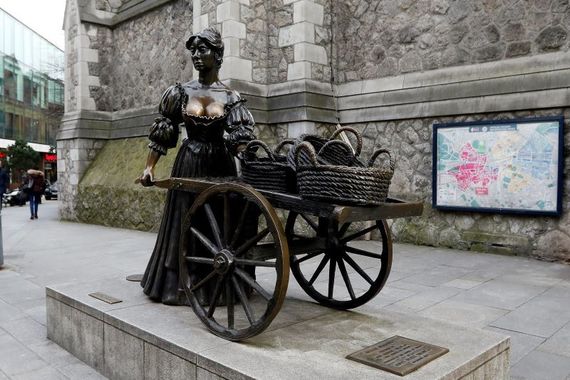
A statue of the famous Molly Malone, located at the crossroads of Andrew Street and Trinity Street.
Your first impression of this fist of tiny intersecting streets is that “this would be the perfect spot for an ambush” – and you would be right. This area is the location of one of Collins’ main finance offices at #3 Andrew Street – right next to the Trocadero Restaurant – but, as your instincts may have warned you, it is also the location of one of the great ambushes gone awry. It was here that Collins and the Squad waited in 1919 for the arrival of Lord French, the Lord Lieutenant of Ireland, as he made his way from Trinity College, heading home to the Viceregal Lodge in the Phoenix Park. Their mission was an assassination. French did not show and Collins dispersed the Squad, wary that his hot tip may have been a British set up.
The Old Stand
Corner of St. Andrew & Wicklow Streets

The Old Stand, on the corner of St. Andrew and Wicklow Streets.
Old Stand Pub, corner of St. Andrew & Wicklow Streets: After going over the books for the National Loan across the street Collins would often meet up with his men here. According to the Old Stand’s website, “From time to time, Collins held informal meetings of the outlawed I.R.B. (Irish Republican Brotherhood) in the premises as true to Collins’ tradition, he was less conspicuous while in the midst of the public.”
Wicklow Hotel & Weir’s Jewelers
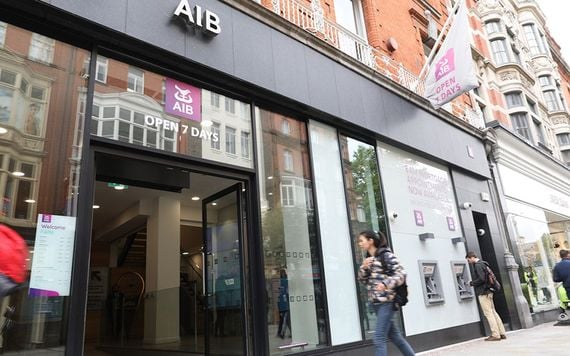
Formerly the Wicklow Hotel, now a bank.
If you turn left and continue down Wicklow Street you will come to the former location of the Wicklow Hotel at #4 Wicklow Street (now a bank). This was a regular hangout for Collins and his Squad. However, the porter, one Willie Dolan, was a British informer and Collins had the Squad take him out. Mrs. Dolan, not knowing that Collins was behind her husband’s death, asked Collins for a pension. Collins granted her request. On the corner of Grafton Street is Weir & Sons, jewelers, where Collins brought the engagement gift, a watch, for his fiancée, Kitty Kiernan, in 1921.
#10 Exchequer Street & The Central Hotel
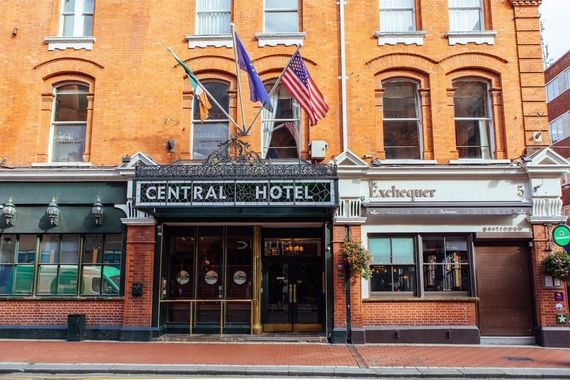
The Central Hotel, currently being developed.
If you backtrack on Wicklow Street it becomes Exchequer Street. #10, to the left of Dunnes Stores, was Collins’ first office in Dublin in 1917. Sadly this hotel is currently being done up but it's hoped it'll return in a modernized but still historic landmark.
It was here that he ran the National Aid and Volunteers Dependents Fund, a charity but also a front for his rebel activities. His office was on the top floor. Across the street is the Central Hotel – now home to one of the great Dublin drinking venues, the fabulous Library Bar – which Collins often used to accommodate visiting I.R.A. men.
The Stag’s Head

The Stag’s Head.
Do an about-face at #10 and you’ll be staring down Dame Court. At the end of it, on the right-hand side, is the Stag’s Head, one of the most beautiful Victorian pubs in Dublin. By day it is quiet and a great place to have lunch. By night it is a mad house. Any time of day or night it is a great pub and was a favorite of the Big Fellow.
After a hard day at #10 he would come here and enjoy a whiskey from “Mick’s Barrel,” which they kept especially for him. The Stag’s Head is within one block of Dublin Castle, the then center of British power in Ireland, and Collins’ used it to meet his agents, keenly aware that British touts might also be on the premises. Many movies have been filmed here, including "Educating Rita," "The Treaty" and one of James Cagney’s last films – and maybe the best film ever made about the Irish revolution – "Shake Hands With the Devil."
Collins’ Alley & #3 Crow Street

Crow Street, Temple Bar.
Right outside the Stag’s Head is a short, yet sinister, tunnel that leads to Dame Street, which I have nicknamed “Collins’ Alley.” If you look directly across the thoroughfare you’ll see Crow Street. At #3 Collins kept his intelligence office, disguised as John F. Fowler, printer and binder. If was through this office – which he seldom visited because of security issues – that Collins’ agents plotted the downfall of the British Secret Service.
#32 Bachelors Walk, the Oval Bar & “The Dump”

The Oval Bar, on Abbey Street.
Let’s make our way to the River Liffey and cross the Ha’penny Bridge. Walk towards O’Connell Street and you’ll come to #32 Bachelors Walk. Collins kept an office here throughout the revolution and, like the Crow Street office, it was never discovered by the British. It is on the corner of Bachelors Way, an alley that leads to Middle Abbey Street. If you look down this alley you’ll see the Oval Bar. The Oval was used by Collins and his Squad perhaps because of its proximity to “The Dump,” a “waiting” room for the Squad on the top floor of the adjacent Eason bookshop building on the corner of Abbey and O’Connell Streets.
General Post Office (GPO) and #16 Moore Street
At O’Connell Street, turn left and you’ll see the portico of the General Post Office. The Easter Rising started here on Monday, April 24, 1916. Collins, then a staff captain, fought in the building alongside the leaders, who included Pádraig Pearse and James Connolly.
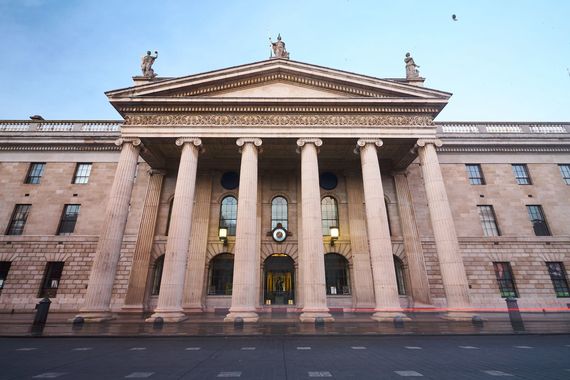
The GPO on O'Connell Street.
By the end of the week, Collins and the other rebels were forced to evacuate the burning GPO and take refuge at #16 Moore Street, off Henry Street. A plaque between the second-floor windows marks the spot. Currently, #16 is being turned into a museum.
Vaughan’s Hotel, #29 Parnell Square
Proceed along colorful Moore Street – its food and fish mongers are straight out of Joyce and O’Casey – to Parnell Street and turn right.
A short walk will take you to the Rotunda Hospital, the oldest maternity hospital in Europe, and Parnell Square, a hotbed of Fenian revolutionary fervor during the War of Independence. Proceed along Parnell Square West until you come to #29. In Collins’ time, this was Vaughan’s Hotel – he called it “Joint Number One” – probably the most important address associated with Collins during this period. He was in and out of the place several times a day even though British “touts” were sniffing about looking for him.

Love Irish history? Share your favorite stories with other history buffs in the IrishCentral History Facebook group.
Mountjoy Street
Continue up Parnell Square and continue past the appropriately named Black Church (the Dublin legend swears that if you run around this foreboding structure three times at midnight the devil himself will appear!). At the corner to the left is the cul-de-sac of Mountjoy Street, almost untouched since the early twentieth century. Collins lived at #44, the Munster Hotel in 1917. (Seán MacDiarmada, a signer of the Proclamation, also spent his last night here prior to the Rising.) As times got hotter Collins was forced to abandon the Munster Hotel as a place of lodging, but he continued to have his laundry done there. Right across the street from #44, one of his girlfriend/agents, Dilly Dicker, lived at #30 and he would park his bike in the lane to the side of the building. Another girlfriend, Susan Killeen, lived at #19.
Hugh Lane Gallery & the Garden of Remembrance
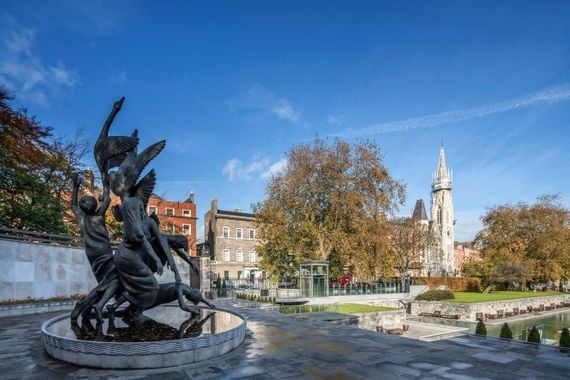
Garden of Remembrance, on Parnell Square.
As we end our tour, we retrace out steps back to Parnell Square and on the north side you’ll find the Hugh Lane Municipal Gallery of Modern Art. Lane, a nephew of Lady Gregory, drowned when the Lusitania was torpedoed. He bequeathed many works of art to the city of Dublin in his will. Inside the front door is a marble bust of Michael Collins by Cork sculptor Seamus Murphy. Also at the Hugh Lane are many paintings by Sir John Lavery, a friend of Collins. It is rumored that Sir John’s wife, Lady Hazel Lavery, was Collins’ secret lover.
The Dublin Writers Museum is also on this block. Across the street is the Garden of Remembrance, directly behind the Rotunda Hospital. In 1916 all the rebels from the GPO, including Collins, were bivouacked here for the night after their surrender. Indignities against two of the leaders, Tom Clarke and Seán MacDiarmada, by a Captain Lea Percival Wilson of the British Army, would bring retribution years later when Wilson was gunned down in Gorey, County Wexford by the Squad on Collins' orders.
It was here that Queen Elizabeth II, on her state visit to Ireland in 2011, laid a wreath in memory of those who died in the fight for Irish freedom.

Queen Elizabeth II bowing during a ceremony at the Garden of Remembrance.
As the Queen stood at attention as the Irish national anthem was played, many Dubliners observed that they wouldn’t be surprised if the ghost of Michael Collins, just across the way at Vaughan’s Hotel, was keeping a close eye on the proceedings – and that he would, finally, approve.
* Dermot McEvoy is the author of "The 13th Apostle: A Novel of a Dublin Family, Michael Collins, and the Irish Uprising and Irish Miscellany" (Skyhorse Publishing). He may be reached at dermotmcevoy50@gmail.com. Follow him at www.dermotmcevoy.com. Follow "The 13th Apostle" on Facebook here.
** Originally published in 2016, updated in June 2023.
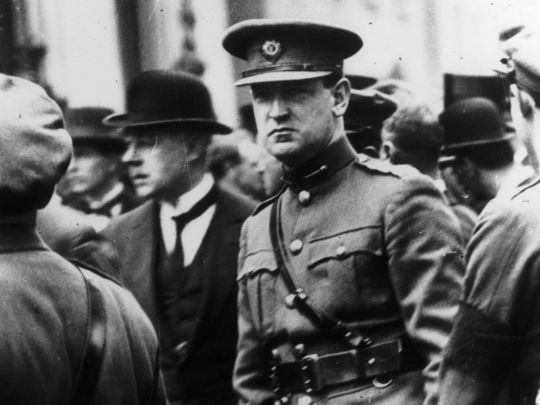
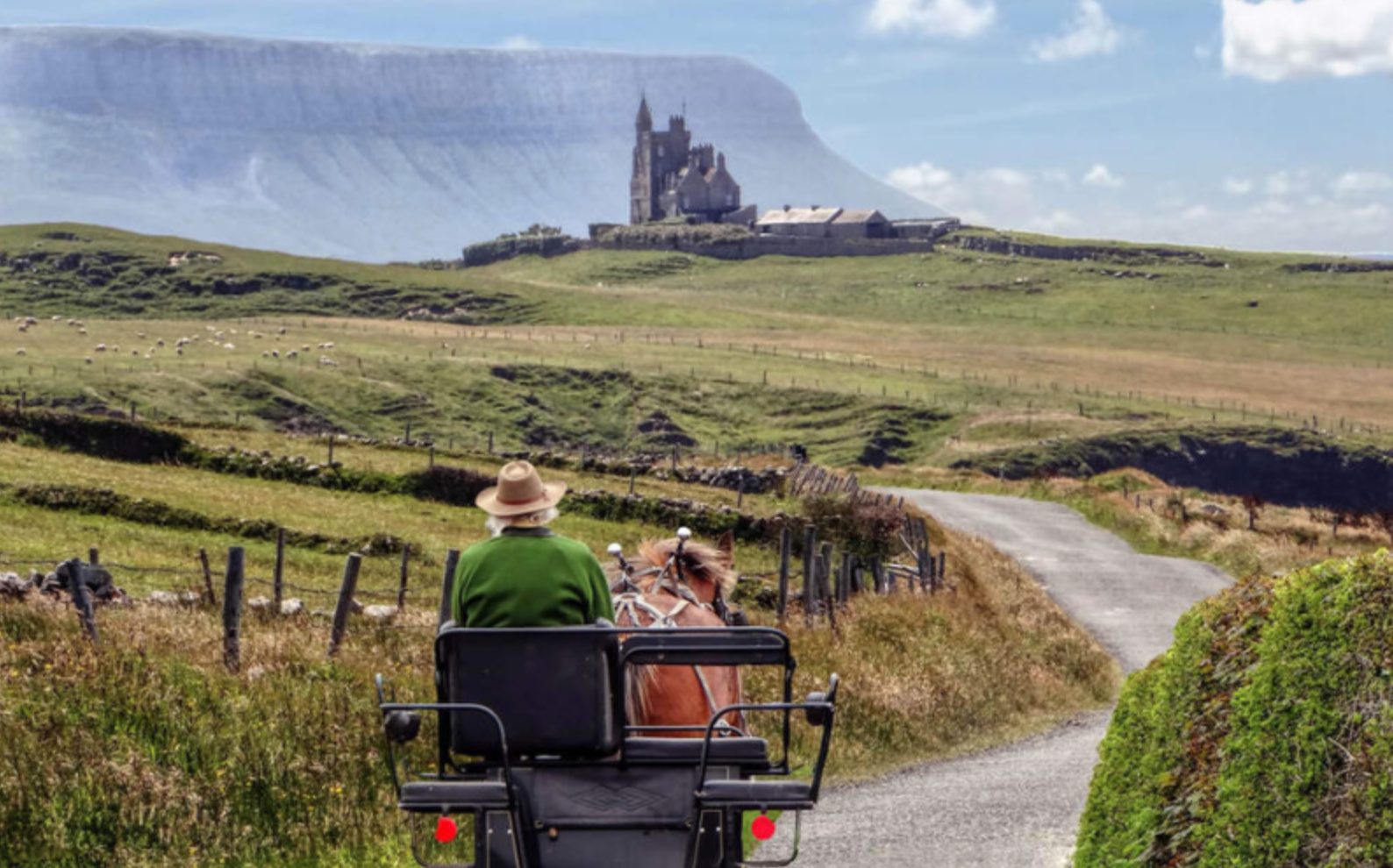


Comments